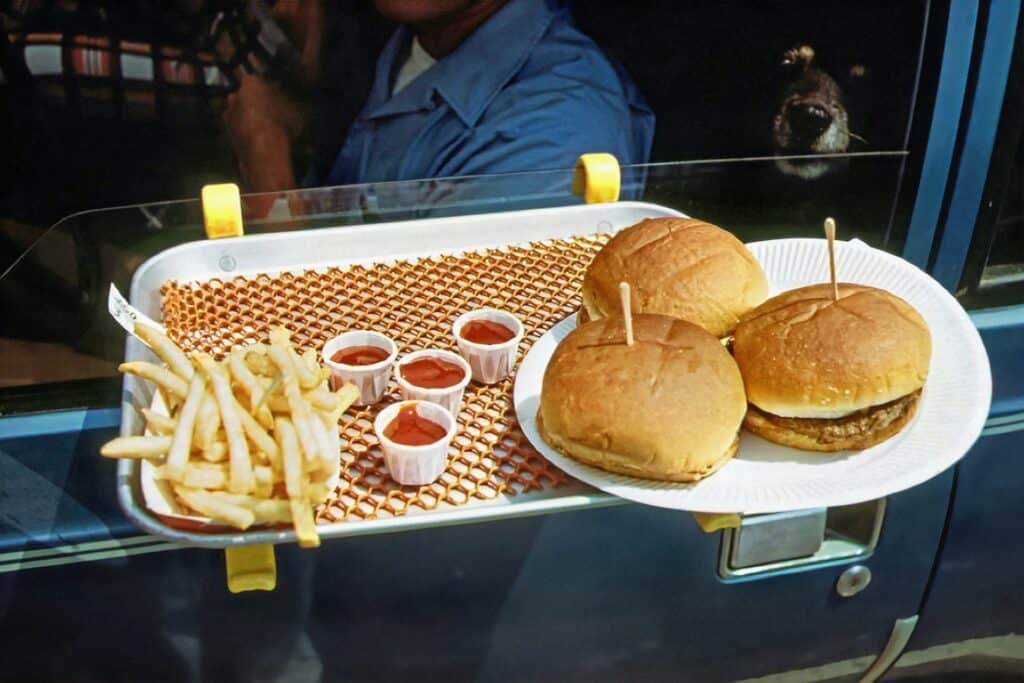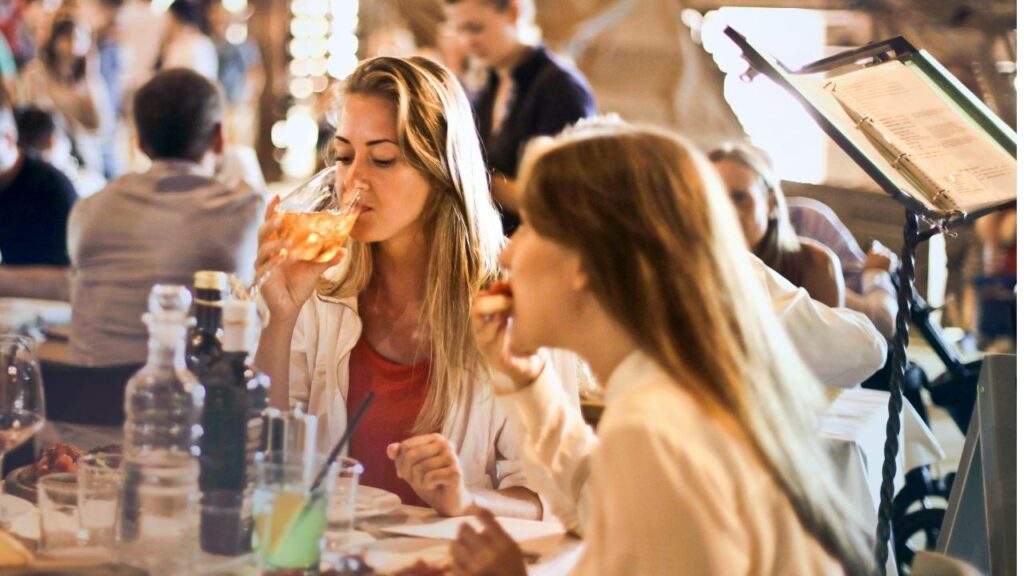We may earn money or products from the companies mentioned in this post. This means if you click on the link and purchase the item, I will receive a small commission at no extra cost to you … you’re just helping re-supply our family’s travel fund.
Lunch used to be an unhurried pause in the day. A tray slid along a cafeteria rail, a plate of roast turkey, a slice of pie, and enough time to swap stories with coworkers. It felt routine and communal. The work whistle set the rhythm, and the neighborhood diner or company canteen delivered the rest.
Across three generations, that rhythm fractured and reformed. Cars made lunch mobile. Malls made it a choose-your-own spread. Office towers stretched it into theater, then laptops squeezed it to a sandwich at the desk. Here’s how we went from steam tables to food courts to delivery pings, and what those shifts say about America’s work, time, and taste.
The Postwar Cafeteria

In the 1950s and 60s, cafeterias ruled the midday hour. They offered predictable menus, quick lines, and prices that fit hourly wages. Employers liked the reliability. Workers liked the comfort. The format made variety feel safe and kept a whole workforce fed within a tight window.
The cafeteria also baked in a social contract. People saw the same faces, traded small talk, and learned the habits of their teams. Lunch was less about customization and more about belonging. In a booming industrial economy, that routine mattered as much as the food.
Drive-Ins, Diners, and the Car Lunch
By the 1960s the car began to steal the show. Drive-ins, drive-throughs, and roadside diners turned lunch into motion. A burger wrapped in paper fit the new pace.
Menus sped up too. Standardized items kept orders predictable, costs low, and lines moving.
The tradeoff was clear. More choice and speed, less ritual.
Brown-bagging adapted alongside. Thermoses and Tupperware gave families control over cost and taste while highways stretched commutes and narrowed time at the table.
The Power Lunch Era

From the 1970s into the 90s, office districts created a different noon culture. The power lunch placed relationships at the center, often in white-tablecloth rooms near financial and media hubs. Deals were framed over club salads and espresso, and a long midday break signaled status as much as hunger.
At the same time, back in the cubicles, salad bars and deli counters multiplied. Choice migrated indoors. Companies began to evaluate productivity in minutes, and the long lunch shifted from norm to exception. A quiet divide opened between showy meetings and desk meals that kept projects moving.
Malls and the Food Court Revolution
The suburban mall changed where teenagers and families gathered, and food courts changed how they ate together. Rows of kiosks shared a common seating pit, which meant one group could split across pizza, teriyaki, and frozen yogurt without a fight. It was democratic and loud, the perfect match for weekend errands.
Two qualities made food courts sticky. First, frictionless choice. Second, a stage for new brands to test ideas without full restaurants. Short leases and modular stalls kept the mix fresh.
Food courts trained Americans to expect global flavors at low risk. Orange chicken and falafel fries went from niche to normal.
When malls dimmed, the format hopped to airports, campuses, and city markets. The playbook survived even as the setting changed.
Workdays Shrink, Lunch Shrinks
Time use surveys tell a simple story. Lunch minutes have been trimmed to make room for meetings, email, and flexible schedules. People eat closer to their desks and often alone. The bite became the norm, the break the exception.
That shift changed product design. Portable salads, grain bowls, and protein boxes replaced knife-and-fork plates. The goal was fuel without fuss. It worked, but it also eroded the social glue that cafeterias once supplied.
Global Flavors Go Mainstream
As immigration reshaped cities and suburbs, lunch followed. Tacos, banh mi, biryani, poke, and Korean bowls moved from specialty strips to downtown staples. Office crowds learned to order by ingredient and heat level. Regional trends spread fast through chains and fast-casual upstarts.
The result was a smarter palate at speed. People wanted bright flavors, clear nutrition claims, and prices that fit a weekday habit. Lunch became a daily micro-tour, often within five blocks of an office lobby or a delivery radius on a phone.
The Tech Campus and the Delivery Boom
Big tech campuses rewrote the cafeteria playbook with chef counters and free meals tied to recruiting and retention. The food was good, the lines short, and the message clear. Stay on campus, build community, and keep projects rolling. For a generation of engineers, this became lunch culture.
Meanwhile, delivery apps redrew the rest of the map. Ghost kitchens, virtual brands, and algorithmic menus met people where they were. Convenience won the hour. The hidden cost was fragmentation. Fewer shared spaces, less casual cross-team contact, and more quiet meals between video calls.
What Sticks and What Comes Next
Three constants endure. People like choice, they value speed, and they remember meals that feel shared. The formats shift, but wins stack where those three meet. A small food hall near transit. A smart in-house cafe with seats for real breaks. A delivery routine that still lands colleagues at the same table twice a week.
Expect hybrid habits to settle in. Some days will be grain bowls at the keyboard. Some will be a loop to a market hall with friends from two floors up. The cafeteria spirit might return in smaller, better forms. Community still tastes good at noon.
Other Blog Posts You Might Enjoy
www.idyllicpursuit.com (Article Sourced Website)
#Cafeterias #Food #Courts #American #Lunch #Changed #Generations #Author #Kathy #Haan
